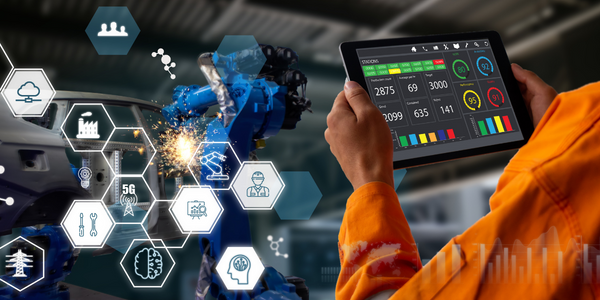ж•°еӯ—еӯӘз”ҹ

жҰӮиҝ°
ж•°еӯ—еҸҢиғһиғҺжҳҜжңүз”ҹе‘ҪжҲ–ж— з”ҹе‘Ҫзү©зҗҶе®һдҪ“зҡ„ж•°еӯ—еӨҚеҲ¶е“ҒгҖӮж•°еӯ—еӯӘз”ҹжҳҜжҢҮеҸҜз”ЁдәҺеҗ„з§Қзӣ®зҡ„зҡ„жҪңеңЁе’Ңе®һйҷ…зү©зҗҶиө„дә§пјҲзү©зҗҶеӯӘз”ҹпјүгҖҒжөҒзЁӢгҖҒдәәе‘ҳгҖҒең°зӮ№гҖҒзі»з»ҹе’Ңи®ҫеӨҮзҡ„ж•°еӯ—еӨҚеҲ¶е“ҒгҖӮж•°еӯ—иЎЁзӨәжҸҗдҫӣдәҶеҜ№иұЎеңЁе…¶ж•ҙдёӘз”ҹе‘Ҫе‘ЁжңҹдёӯеҰӮдҪ•иҝҗиЎҢзҡ„е…ғзҙ е’ҢеҠЁжҖҒгҖӮж•°еӯ—еӯӘз”ҹжҠҖжңҜзҡ„е®ҡд№үејәи°ғдәҶдёӨдёӘйҮҚиҰҒзү№еҫҒгҖӮйҰ–е…ҲпјҢжҜҸдёӘе®ҡд№үйғҪејәи°ғзү©зҗҶжЁЎеһӢдёҺеҜ№еә”зҡ„иҷҡжӢҹжЁЎеһӢд№Ӣй—ҙзҡ„иҒ”зі»гҖӮе…¶ж¬ЎпјҢиҝҷз§ҚиҒ”зі»жҳҜйҖҡиҝҮдҪҝз”Ёдј ж„ҹеҷЁз”ҹжҲҗе®һж—¶ж•°жҚ®жқҘе»әз«Ӣзҡ„пјҢд»ҘжҸҗдҫӣеҜ№зү©зҗҶеҜ№иұЎеҪ“еүҚзҠ¶жҖҒзҡ„жј”еҸҳи§Ҷи§’гҖӮж•°еӯ—еҸҢиғһиғҺзҡ„жҰӮеҝөеҸҜд»ҘдёҺе…¶д»–жҰӮеҝөиҝӣиЎҢжҜ”иҫғпјҢдҫӢеҰӮи·ЁзҺ°е®һзҺҜеўғжҲ–е…ұеҗҢз©әй—ҙе’Ңй•ңеғҸжЁЎеһӢпјҢе…¶зӣ®зҡ„жҳҜжҖ»дҪ“дёҠе°Ҷзү©зҗҶдё–з•Ңзҡ„дёҖйғЁеҲҶдёҺе…¶зҪ‘з»ңиЎЁзӨәеҗҢжӯҘгҖӮ
жЎҲдҫӢз ”з©¶.

Case Study
Battery manufacturer Industrial Digital Twin
For optimum control of product quality, Banner relies on a high production depth. Its 560 production employees produce nearly all the components in¬-house that they need to make finished batteries on Banner’s six assembly lines. This includes the plastic parts for the battery cases as well as the paste-filled lead oxide grids. Their production involves two to five¬ days rest in maturing chambers to create optimum current absorption and storage capacity. Banner’s ongoing success was accompanied by a continuous, organic growth of the production facilities, adding or extending hall after hall until the complex filled the site that had seemed ever so spacious when the company moved here from a smaller place in 1959. These developments led to a heterogeneous production environment. “This confronts us with significant challenges, particularly concerning intra¬logistics issues, such as scheduling for the maturing chambers,” says Franz Dorninger, technical director at Banner. “We contemplated various ways to overcome this problem, including relocating to new premises.”

Case Study
Leveraging the IoT to Gain a Competitive Edge in International Competition
Many large manufacturers in and outside Japan are competing for larger market share in the same space, expecting a growing demand for projectors in the areas of entertainment, which requires glamor and strong visual performance as well as digital signage that can attract people’s attention. “It is becoming more and more difficult to differentiate ourselves with stand-alone hardware products,” says Kazuyuki Kitagawa, Director of Service & Support at Panasonic AVC Networks. “In order for Panasonic to grow market share and overall business, it is essential for us to develop solutions that deliver significant added value.” Panasonic believes projection failure and quality deterioration should never happen. This is what and has driven them to make their projectors IoT-enabled. More specifically, Panasonic has developed a system that collects data from projectors, visualizes detailed operational statuses, and predicts issues and address them before failure occurs. Their projectors are embedded with a variety of sensors that measure power supply, voltage, video input/ output signals, intake/exhaust air temperatures, cooling fan operations, and light bulb operating time. These sensors have been used to make the projector more intelligent, automatically suspending operation when the temperature rises excessively, and automatically switching light bulbs. Although this was a great first step, Panasonic projectors were still not equipped with any capability to send the data over a network.

Case Study
CN Helped Pine Printshop with a Responsive and Top-notch E-commerce Portal
To digitally expand their business, Pine Printshop was looking for a catalog-based site that would help people buy ready-made products (e.g. apparels, board pins, stickers, etc.) and even allow customers to personalize their own t-shirts, caps, and hoodies.

